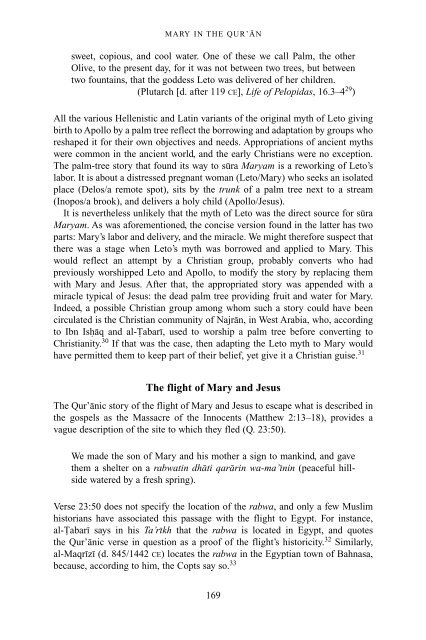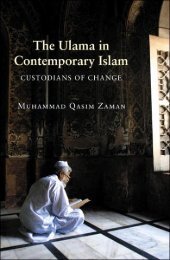The Qur'an in its historical context (pdf - Islam and Christian-Muslim ...
The Qur'an in its historical context (pdf - Islam and Christian-Muslim ...
The Qur'an in its historical context (pdf - Islam and Christian-Muslim ...
You also want an ePaper? Increase the reach of your titles
YUMPU automatically turns print PDFs into web optimized ePapers that Google loves.
MARY IN THE QUR’AN<br />
sweet, copious, <strong>and</strong> cool water. One of these we call Palm, the other<br />
Olive, to the present day, for it was not between two trees, but between<br />
two founta<strong>in</strong>s, that the goddess Leto was delivered of her children.<br />
(Plutarch [d. after 119 CE], Life of Pelopidas, 16.3–4 29 )<br />
All the various Hellenistic <strong>and</strong> Lat<strong>in</strong> variants of the orig<strong>in</strong>al myth of Leto giv<strong>in</strong>g<br />
birth to Apollo by a palm tree reflect the borrow<strong>in</strong>g <strong>and</strong> adaptation by groups who<br />
reshaped it for their own objectives <strong>and</strong> needs. Appropriations of ancient myths<br />
were common <strong>in</strong> the ancient world, <strong>and</strong> the early <strong>Christian</strong>s were no exception.<br />
<strong>The</strong> palm-tree story that found <strong>its</strong> way to sura Maryam is a rework<strong>in</strong>g of Leto’s<br />
labor. It is about a distressed pregnant woman (Leto/Mary) who seeks an isolated<br />
place (Delos/a remote spot), s<strong>its</strong> by the trunk of a palm tree next to a stream<br />
(Inopos/a brook), <strong>and</strong> delivers a holy child (Apollo/Jesus).<br />
It is nevertheless unlikely that the myth of Leto was the direct source for sura<br />
Maryam. As was aforementioned, the concise version found <strong>in</strong> the latter has two<br />
parts: Mary’s labor <strong>and</strong> delivery, <strong>and</strong> the miracle. We might therefore suspect that<br />
there was a stage when Leto’s myth was borrowed <strong>and</strong> applied to Mary. This<br />
would reflect an attempt by a <strong>Christian</strong> group, probably converts who had<br />
previously worshipped Leto <strong>and</strong> Apollo, to modify the story by replac<strong>in</strong>g them<br />
with Mary <strong>and</strong> Jesus. After that, the appropriated story was appended with a<br />
miracle typical of Jesus: the dead palm tree provid<strong>in</strong>g fruit <strong>and</strong> water for Mary.<br />
Indeed, a possible <strong>Christian</strong> group among whom such a story could have been<br />
circulated is the <strong>Christian</strong> community of Najran, <strong>in</strong> West Arabia, who, accord<strong>in</strong>g<br />
to Ibn Ishaq <strong>and</strong> al-Tabari, used to worship a palm tree before convert<strong>in</strong>g to<br />
<strong>Christian</strong>ity. 30 If that was the case, then adapt<strong>in</strong>g the Leto myth to Mary would<br />
have permitted them to keep part of their belief, yet give it a <strong>Christian</strong> guise. 31<br />
<strong>The</strong> flight of Mary <strong>and</strong> Jesus<br />
<strong>The</strong> Qur’anic story of the flight of Mary <strong>and</strong> Jesus to escape what is described <strong>in</strong><br />
the gospels as the Massacre of the Innocents (Matthew 2:13–18), provides a<br />
vague description of the site to which they fled (Q. 23:50).<br />
We made the son of Mary <strong>and</strong> his mother a sign to mank<strong>in</strong>d, <strong>and</strong> gave<br />
them a shelter on a rabwat<strong>in</strong> dhati qarar<strong>in</strong> wa-ma’<strong>in</strong><strong>in</strong> (peaceful hillside<br />
watered by a fresh spr<strong>in</strong>g).<br />
Verse 23:50 does not specify the location of the rabwa, <strong>and</strong> only a few <strong>Muslim</strong><br />
historians have associated this passage with the flight to Egypt. For <strong>in</strong>stance,<br />
al-Tabari says <strong>in</strong> his Ta’rikh that the rabwa is located <strong>in</strong> Egypt, <strong>and</strong> quotes<br />
the Qur’anic verse <strong>in</strong> question as a proof of the flight’s historicity. 32 Similarly,<br />
al-Maqrizi (d. 845/1442 CE) locates the rabwa <strong>in</strong> the Egyptian town of Bahnasa,<br />
because, accord<strong>in</strong>g to him, the Copts say so. 33<br />
169



